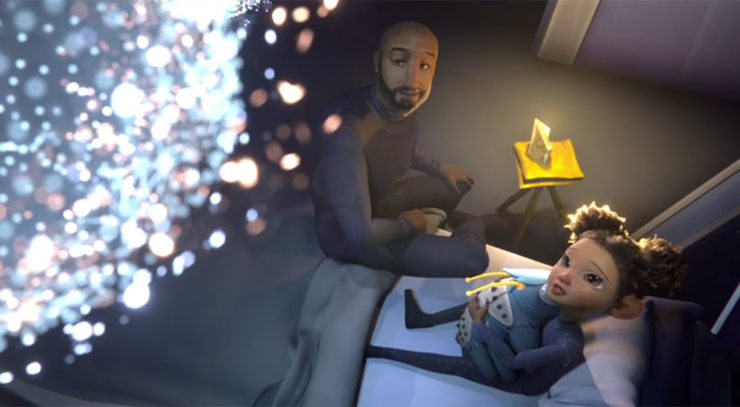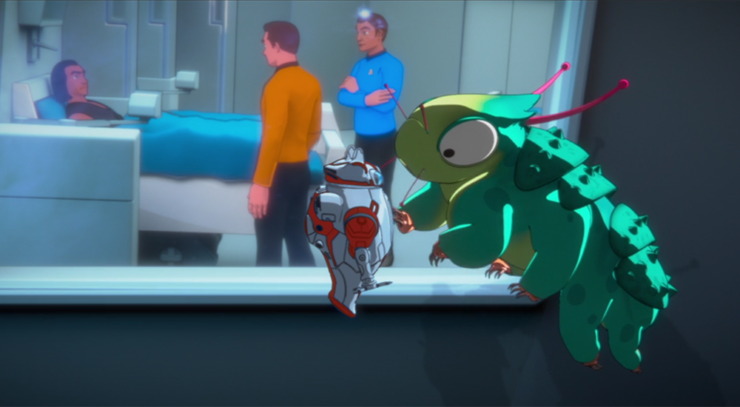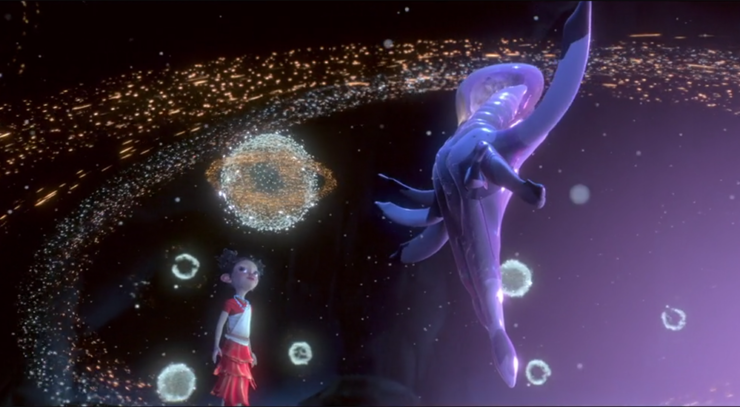Back in the 1970s, Star Trek was proving more popular in syndicated reruns than it ever was as a new show on NBC in the 1960s. Gene Roddenberry was looking for ways to capitalize on that popularity, and while attempts to revive the show in live-action were made—a movie, then a TV show, then a movie again, which finally happened in 1979—he also succeeded in reviving the series via animation by doing a deal with Filmation for an animated show that lasted twenty-two episodes.
For the first time since that animated series ended in 1974, Star Trek has produced an animated episode. In fact, they’ve done two.
The Filmation series from 45 years ago was primitive, to say the least. By the time Roddenberry and D.C. Fontana joined forces with Hal Sutherland to do Star Trek in animated form, mainstream animation had fallen quite far from the heyday of Walt Disney and Warner Brothers, with beautiful animation and superlative voice work replaced by cheap animation and a lot of reuse of the same actors for multiple voices. That works if you’re Mel Blanc, less so if you’re, well, not Mel Blanc.
As a result, while the writing on the animated Trek was generally quite good—with a lot of the scripts coming from veterans of the live-action show—the quality of the animation was of the somewhat cheap quality that had become the hallmark of animated television that aired on Saturday mornings four decades ago.
Once Trek was revived in live-action, the notion of a new animated series never took off, even as animation itself went through a sea change in the 1990s, with Ren & Stimpy and Reboot and the works of folks like Bill Plympton and other bleeding-edge creators leading the charge into more complex animated series, and with Batman: The Animated Series leading the way in making mainstream animation more complex and mature as well.
Over the last couple of decades, the notion of a new animated series had been floated by fans, but never really taken seriously until Secret Hideout took over producing Trek TV for CBS All Access, and now we have two animated series in development: Lower Decks, which is for CBSAA, and another as-yet-untitled show that is actually going to be shown on Nickelodeon, in an attempt to broaden Trek’s audience to the next generation of fans.
To whet our appetites for both those shows, the latest Short Treks releases are animated shorts of less than ten minutes, both of which tie in to Star Trek: Discovery.
“The Girl Who Made the Stars”

“The Girl Who Made the Stars” hearkens back to the second-season premiere of Discovery, “Brother,” in which Michael Burnham in voiceover told the story of the girl who made the stars, a story from millennia ago told by the /Xam Abathwa people of southern Africa. In the animated short, we get a little Michael Burnham, before the Klingons killed her parents, being told a version of the story by her father.
One of the cool things about myths and storytelling is that stories change with the retellings. Times change, people change, assumptions change, and stories adjust to fit the time in which they are told and the people who are telling them. (It’s why I don’t stress about the differences in technology between the 1966 version of the 23rd century in the original Trek and the 2017 version of it in Discovery.)
The creation myths of the peoples of the Kalahari Desert were told to explain why the world was the way it was. They explained the stars in the night sky by telling of a girl who threw embers into the air in order to provide light during the night, so people could navigate. The girl was lonely and wanted to visit other people.
But the version that the elder Burnham tells his daughter, who is frightened of the dark and can’t sleep, is both the same and different.
For starters, Burnham has adjusted the story to a more 23rd century sensibility. And so the girl of the story is inspired to light up the night sky, not by loneliness, but by encountering an alien life form, who assures her that they’re not alone in their little valley. The girl’s people have not gone beyond their home because it would take more than a day to get there and the night is completely dark and would destroy them. But the girl illuminates the night with stars by which one can navigate, inspired by meeting the strange alien.
It’s a story designed to make a girl who lives in a big galaxy full of different types of sentient beings not to be afraid of the dark, and it works quite beautifully that way. The animation is excellent, and it’s frankly nice to see a non-Christian creation myth given this kind of play.
The episode was written by Discovery staffer Brandon Schultz, who also helps run an animation studio, Street Legends Ink, which has produced a bunch of nifty content, including an animated short that is on the Blade Trinity DVD, and is producing an animated film based on the comic book Blokhedz, on which Schultz served as a writer. It was directed by Discovery executive producer Olatunde Osunsanmi, who is one of the show’s best directors.
“Ephraim and Dot”

In “Ephraim and Dot,” we get something much sillier. Michael Giacchino—who did the music for all three Bad Robot–produced Trek films—sits in the director’s chair for this one (which he also did the music for, using a lot of cues from the original series and the movies), over a script by Discovery staff writers Chris Silvestri & Anthony Maranville.
It’s presented as an In Search Of…-style nature documentary about a tardigrade trying to lay its eggs, complete with very Leonard Nimoy-esque narration by Kirk Thatcher.
First of all, the tardigrade is just adorable. Ephraim is trying to lay eggs, and they need to be laid in a warm place. The original plan is to lay them on an asteroid, but said asteroid is then destroyed by the deflector dish of the U.S.S. Enterprise.
No matter what else happens in this short, I adore the fact that the Enterprise looks like it’s straight out of the Filmation series. Having lost the asteroid, Ephraim manages to get into the Enterprise itself, but is menaced by a DOT-7 maintenance robot (of a type we’ve seen a few times in both Disocvery and Short Treks). Ephraim manages to lay the eggs near the warp core before Dot catches up and tosses the tardigrade out into space.
From that point on, Ephraim keeps chasing the Enterprise, not actually catching up to it until right before its destruction in Star Trek III: The Search for Spock. However, right before the ship goes boom, Dot realizes that there are eggs there, and saves them. Ephraim is thrilled and goes off not just with the little tardigrade babies, but with Dot, too, who’s now part of the family.
The Trek nerd in me wants to nitpick the crap out of this. Ephraim comes across Khan talking to Kirk and McCoy in sickbay shortly after he’s been revived in “Space Seed,” and then after that overhears Sulu thinking he’s a Musketeer when suffering from the Psi 2000 virus in “The Naked Time“—which happened before “Space Seed.” And between those two, Ephraim finds tribbles, which infested the Enterprise in “The Trouble with Tribbles” after both those episodes. And when Ephraim is chasing the ship, we get references to “Who Mourns for Adonais?” “The Doomsday Machine,” “The Tholian Web,” “The Savage Curtain,” and Star Trek II: The Wrath of Khan, before the tardigrade finally catches up with the ship right when it encounters Kruge’s Bird of Prey in The Search for Spock. (And in that bit, the registry says “NCC-1701-A,” which is wrong, as that’s a different ship that didn’t debut until the end of the next movie.)
None of that makes sense. In particular, the Enterprise was actually stationary (as much as anything can be in space, anyhow) while it was being refit just prior to Star Trek: The Motion Picture, and received a massive overhaul. (1) How did Ephraim not catch up to it then? (2) How did all the engineers miss the pile of tardigrade eggs?
Now, the Mycelial network is a place of weirdness, and maybe tardigrades have a different relationship with time than we do.
Or maybe it’s a nature documentary that got its facts wrong. This is the interpretation I’m going with, because the Trek nerd in me is being overruled by the guy in me who thinks the tardigrade is adorable and who thinks Dot is just as adorable, and who was rooting for Ephraim to save the little tardigrade babies. And if the Trek nerd in me has a problem with that, he can be comforted by the awesome factor of seeing animated versions of Khan, Kirk, McCoy, and Sulu and hearing their voices, which is just fabulous.
No, seriously, I was sitting there on my couch, 50 years old, a grown-ass human, going “Oh no!” when the Enterprise self-destruct sequence started, because I was worried about the tardigrade eggs that I knew damn well were going to be rescued because this is television and this is Star Trek and that’s how these things work.
And that’s what good storytelling can do. Best of all, though, is that for all that it’s got cuteness and fan service and the image of Abraham Lincoln shaking his fist at the Enterprise to tell them to get off his lawn (no, really, that’s what it looks like!), it’s also got a very Star Trek message at its heart. Dot and Ephraim start out opposed, because Dot only sees an intruder on the ship. But once Dot realizes that Ephraim just wants to protect the eggs, the robot works to save them, and we get a happy ending that comes about because of compassion and cooperation. Which is what Trek is all about.
But yeah, it helps that both Ephraim and Dot are cute as hell. Oh, and as an added bonus, the Enterprise computer is voiced by none other than Jenette Goldstein, a.k.a. Vasquez in Aliens (and who also appeared as an Enterprise-B science officer in Star Trek Generations). The nerd in me seriously adores that…
These two shorts are fun and delightful and disposable, but the first two obviate the third. They also have two completely different styles, which is encouraging. It means they’re not just thinking of animated Star Trek as a monolithic thing, but taking different approaches. It’s encouraging as hell for what we’ll see from Lower Decks and the Nickelodeon show.
The last Short Trek of this batch will be a prequel to Star Trek: Picard, to be released on the 10th of January, entitled “Children of Mars.”
Keith R.A. DeCandido has been writing about pop culture for this site since 2011, including the current “4-Color to 35-Millimeter: The Great Superhero Movie Rewatch” every Friday, rewatches of several Star Trek shows (including the animated series), and reviews of every episode of Star Trek Discovery and Short Treks to date. In 2020, his reviews of Short Treks, Star Trek: Picard season one, and Star Trek: Discovery season three will run the day after each episode goes live.










